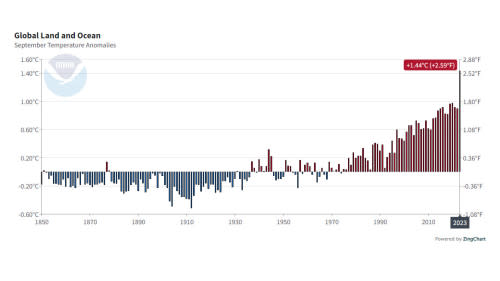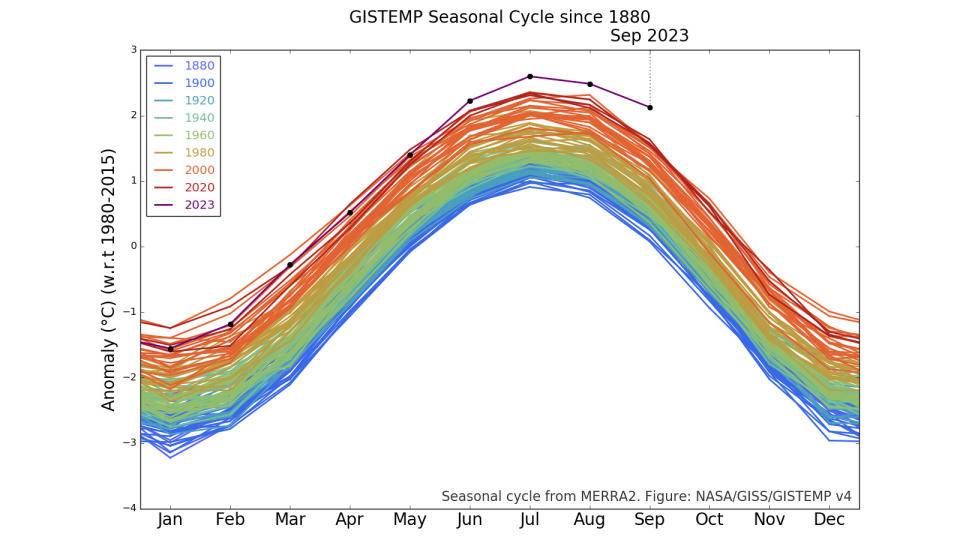2023 could be the first year to exceed a global climate threshold

Scientists expressed shock as the first tally of global temperatures came in for September, but the exceptional heat so far could push 2023 to become the very first year to exceed the 1.5°C temperature threshold set by the 2015 Paris Agreement.
Europe's Copernicus Climate Change Service and the World Meteorological Organization first broke the news that September 2023 was — by far — the hottest month of September ever recorded. According to Copernicus, the month's global average temperature exceeded their previous record in September 2020 by half a degree Celsius (0.5°C). It was also roughly 1.75°C higher than the September temperature in the pre-industrial era.
No doubt struggling to find the right words to express how shocking this was, Berkeley Earth scientist Zeke Hausfather called it "absolutely gobsmackingly bananas."
Having conducted their own analyses of the data, NASA, NOAA, and Berkeley Earth have confirmed Copernicus' basic results. Each agency now ranks September 2023 as the hottest month of September on record. Some of these records, such as NOAA's, go back as far as 1850.

This time-series graph plots all September global average temperatures from 1850-2023. September 2023 exceeds all other months, including the previous record in 2020, by a staggering amount. (NOAA NCEI)
"September 2023 was the fourth month in a row of record-warm global temperatures," NOAA Chief Scientist Dr. Sarah Kapnick said in an agency press release. "Not only was it the warmest September on record, it was far and away the most atypically warm month of any in NOAA's 174 years of climate keeping."
"To put it another way, September 2023 was warmer than the average July from 2001-2010," Kapnick explained.
"What's remarkable is that these record values are happening before the peak of the current El Nino event, whereas in 2016 the previous record values happened in the spring, after the peak," Gavin Schmidt, director of NASA's Goddard Institute for Space Studies, said in a statement on the NASA website.
Through 2015 and 2016, we saw an extreme El Niño event develop in the equatorial Pacific Ocean — one of the strongest since record-keeping began. At that time, the excess heat this climate pattern was releasing from the ocean caused 2015 to become the new hottest year on record. This record stood for precisely 1 year until 2016 took its place.
With a new El Niño pattern developing in the Pacific Ocean, we are now at the equivalent of September 2015. The pattern is growing and becoming more intense but hasn't peaked yet. So, we would expect any month-by-month temperature increases — if any — to still be relatively small.
According to NOAA, September 2015's record, at the time, was +0.90°C above the 20th century average — an increase of only 0.03°C over the previous record of +0.87°C set in 2014.
By comparison, NOAA's new tally of September 2023 global temperatures is +1.44°C above the 20th century average. That's an incredible 0.46°C hotter than September 2020's record-holding temperature of +0.98°C!
NASA's records show a similar temperature increase over previous Septembers.

NASA's GISTEMP Seasonal Cycle graph shows monthly average temperatures from the globe compared to their average from 1980-2015. June, July, August, and September of 2023 are significantly warmer than in any year going back to 1880. (NASA GISS)
First year to surpass 1.5°C threshold?
By analyzing this year's temperature trends and comparing them to previous years, both NOAA and Berkeley Earth state that 2023 has an over 99 per cent chance to be the next hottest year on record.
However, based on Berkeley Earth's latest assessment, the odds are also overwhelmingly in favour of 2023 becoming the first year on record with an annual global temperature that will exceed a major climate milestone.
"We now consider there to be a 90% chance that 2023 has an annual-average temperature anomaly more than 1.5°C/2.7°F above the 1850-1900 average," Berkeley Earth scientist Robert Rohde wrote in his September update. "This is a sharp increase from last month's report, when only a 55% chance of a 1.5°C anomaly was forecast."
"Prior to the start of 2023, the likelihood of a 1.5°C annual average this year was estimated at ~1%," Rohde added. "The fact that this forecast has shifted so greatly serves to underscore the extraordinarily progression of the last few months, whose warmth has far exceeded expectations."
Up until 2023, the prevailing opinion seemed to be that we were still years or perhaps decades away from when global average temperatures would permanently exceed 1.5°C — the optimistic climate limit established by the 2015 Paris Agreement.
To underscore this, a May 2022 report from the WMO and the UK Met Office said there was only a 50-50 chance that just one year between 2022 and 2026 would exceed that milestone.
Seeing global temperatures breach that milestone just one year later would be remarkable. It becomes even more alarming when you consider two facts: 1) the second year of an El Niño is always warmer than the first, and 2) significant El Niño events have a tendency to set a new 'plateau' for global temperatures to follow in the 5-10 years after. Based on that, we could be closer to permanently breaching that 1.5°C climate threshold than we think!
(Thumbnail courtesy NASA GISS)

